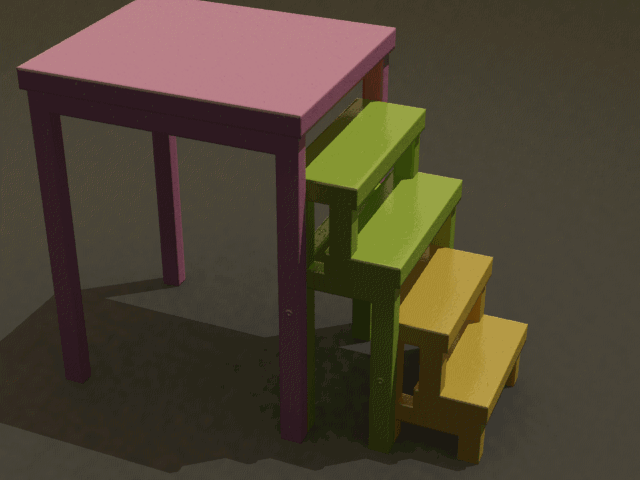Introduction: The Foldable Table-step
Since my last stool-step project reached a good popularity I decided to improve that design and make something totally new: a foldable table-step!

It was not easy making all fitting right but I reached a good design and as you can see from the animation it (should) work great!
Step 1: The Project
Step 2: Closed
The closed table lets you to sit at one side and use the other side as working surface. The stairs don't touch the floor, and they leave a space very handy for your feet. Anyway the dimensions of the table are easily customizable, since you only have to keep the right measures in vertical, and you can enlarge or make the table deeper.
Step 3: Open
When you open the steps you will find a very stable stair with 5 steps reaching 75 cm of height which is quite normal for a table. The steps are divided in two bodies and they have different width, so you have to pay attention to that when you descend from the top.
Step 4: Side Views
Each step has the same deepness of 15.5 cm, and they all are equally spaced from the outer side to the table edge.
The height of the steps is 15 cm, this is also not much and very handy to climb.
Step 5: The Three Bodies
Here you can see the three bodies isolated one from each other. These parts have to be joined with three steel pivots, to be placed where you see the holes. The small cylinders that you see can be made from wood, since they only keep the steps in position when the stair is closed, and they also act as lockers when you open it, but on a planar floor they should not make any effort.
Step 6: Grooves Details
You can also easily see the holes for the pivots and the grooves where some other pivots will insert, to avoid that the steps fall inside the table.
In the detail notice that these grooves have to be milled with a V shape, that because the circular movement around the pivots will otherwise create some interference.
Step 7: Dimensions
Of course you need all dimensions to make this project. I show you here the measures on the horizontal projection for all the three groups.
Step 8: Heights
Here are the essential measures of any joint and pivot, and some other height of the structures and wood boards.
Please pay attention that any measure in height comes from an exhaustive study and you cannot change one of them without checking all the others.
My wood bars are 3.5 x 4.5 cm, and the boards are 4.5 thick. If you have wood boards and bars with different height or dimension you should change all the project, but feel free to ask in the forum for help.
Step 9: Animation in Detail
At last another animation when you can see in detail the movement of the steps and the joints for the locking pivots.
It's not easy to see but there are wood cylinders that fits in the grooves and keep the two moving parts locked in place in both limit positions, open and closed.

I hope you have time and patience to make this awesome piece of furniture, and please post your work in the forum, that will be very interesting. For what refers myself I'm trying to find out the time to build it, in that case I will update this instructable.
Step 10: 3D Model
Iif you wish to try making a scale model with your 3D printer here is the .stl file :-)
Attachments
Step 11: [UPDATE] the Realization
After some time I made it! And now I can show you the process of making this original table-step!
Step 12: Cutting and Drilling
After cutting all the pieces I used wood dowels and glue to connect pieces together.
As you can see in the picture you can buy metal tiny cylinders with a spine on one face, so that it will help you to find the exact center for the opposite hole. Just drill the first hole, insert the cylinder, place the opposite part in the right position and press it tight against the spine. use the cavity left by the spine to mark the center of the new hole.
Step 13:
Step 14:
Step 15:
Step 16:
Step 17:
Step 18:
Step 19:

Participated in the
Wood Contest














